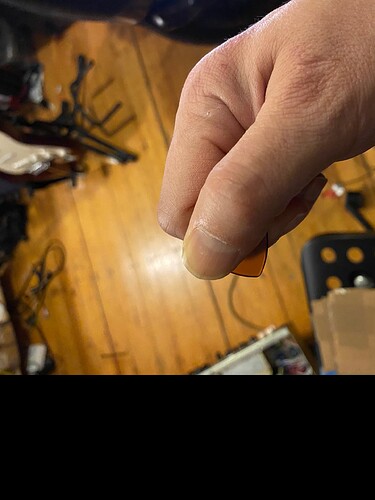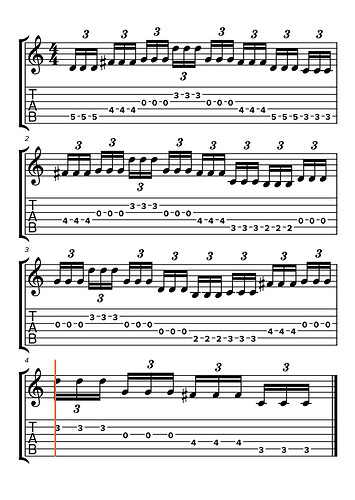Your not far off, so it wouldn’t be a wild adjustment.
I think Troy commented on another thread correcting that saying it wasn’t string hopping but he was doing the basic movement but just not flat enough. I’ll see if I can find the post again, I came across it when scouring the forum. That being said, when I try and intentionally make myself string hop I cap out at like triplets at 130-140.
Ah ok, that would be cool clarification. I’d suspect there are ‘degrees’ to this. Like:
Can’t go faster than 16ths @ 120 → String hopping
Can go faster than 16ths @ 120 BUT can’t go faster than 130 → bad string tracking OR inconsistent motion on certain strings etc.
After all there is no silver bullet for this it seems. Also I watched your March 26 clip and agree you’re on the right track with that. It looks effortless compared to your other stuff. A motion like that is definitely worth keeping and refining.
String hoping has a very visual appearance with very pronounced wrist extensions like one of those bird pecking toys. What I see is the opposite of string hopping in that it’s slightly too flat. It’s part of the reason I designed that lick and the next one that will follow.
Hi Fossegrim, here’s me playing the etude I think around 16ths at 130. Rn this is the sort of limit at where I can semi accurately play the etude. March 29, 2022 - YouTube
I feel like the past several days whatever I did in the march 26tn video is starting to get more consistent with the feeling the wrist extension on the downstrokes being more in command and I’ve been trying to add in more elbow movement for string tracking.
Okay. I see what’s happening, it’s generally pretty much what we discussed before but there are a few things I will add that may help facilitate this. I’m going to post a video reply maybe to see if that helps out a little more than just listing things. I’ll also post part two of this little exercise later tonight.
But one thing I may want to get you used to, is the idea that perhaps you may need to utilize different forms for different things, and it may seem awkward at first.
Totally interested in this, I’m at roughly the same state as Parkerlicks at your etude (I crash and burn at about 110 though) I am curious though, what do you mean by different forms for different things?
It was somewhat purposely vague, but essentially a couple of things I saw in @ParkerLicks might make trying to get a subtle rotation a bit more awkward for some vs others. A lot of it is really preference but some of it can just be minor adjustments that may help get the motion going a little easier.
The first thing I noticed was pick grip. He is holding the pick more in between the first and second knuckle like this:
This in it of itself is a preference, but for some this might force the hand closer to the strings, making some of the more subtle rotation harder to do, or make it harder to escape the plane on both downstrokes and upstrokes. It also may be why some feel the need to apply more wrist extension to escape the plane of the strings when trying to do playing that requires some form of DBX. Holding the pick a little further down, like below may give a bit more freedom of movement, but again it’s a player by player basis:
The next thing is to maybe try exaggerating the motion a bit, and at a slower speed to ingrain both it, and string tracking. Below is a video of the first bits of the pattern being played more slowly so you can see the required movements clearer. I’m exaggerating the rotation aspect a little so you can see it. It’s apparent, but not so much that you see a vertical hopping motion. but when it’s sped up, a lot of these visual queues go away, and it looks flatter.
Here is is at roughly the speed that @ParkerLicks attempted. You can see some of the visual queues go away and it looks flatter, but it’s still there:
Below is the second lick that will help with the tracking and making sure you get the motion right. You can kind of see where I’m going with this, and you can apply this to what ever chords or progressions you want. This is just a repeating three chord pattern, the chords them selves are unimportant:
I’ll experiment with pick grip and post a video of the new lick in the next couple days. Thank you.
Hmmn Thought I’d post a run at Fossegrim’s lick - the first one. Not sure what to change or try at this point. I will say though that the dialogue here is inspiring enough to try ‘something’ lol I had pretty much almost settled into having “given up” because of how bloody intangible this is…
Not sure what tempo this is I am playing at, but it’s just on the verge of falling apart, or completely disintegrating into a swishy strum. Although I am trying to mute and keep it so that it sounds somewhat like music so maybe that’s part of the problem too… Another annoying thing is that I keep hitting my volume knob and turning the volume down! So probably 16ths at around 100-110 range. Ah well, funny stuff. Maybe Parkerlicks sees something that I am doing that will help him NOT to do and therefore succeed hahahaha
I’m no Troy Grady and I’m struggling with this myself so take this with a grain of salt but to me it looks like you might be mixing string hopping with actual crosspicking esque motions. Some of the slow motion movements look like you are using extension on both strokes and others flatter. It is at a speed that you can’t rule out stringhopping at so maybe try just flooring it with a different roll pattern. I definitely have some sort of movement I can do at speeds that are past the stringhopping threshold, albeit not very accurately or consistently so maybe that’s a good first step. Can you do a single escape movement quickly and fluidly?
I’ll be able to post a video of the new lick and different pick grip on Friday, very busy ATM but appreciate all the help.
Hey thanks for checking it out man! Yeah, I know it’s pretty rough! Imagine my dilemma- I am the guy who can’t even crosspick or DBX or 2waypickslant or whatever!
You know, I’ll try to do another video but maybe be a little more descriptive on the how’s. I sort of rushed it the other night just because I wanted to get at least something up before people just gave up and moved on. I relied too much on visual queues and not enough on actually explaining anything.
You have the polar opposite issue of @ParkerLicks. If you guys traded a little of each other’s hand motion, you would both have it down. Scott, you are a bit overzealous with the motions, almost like an early morning late for work cortisol rush. If you notice, even with my video of the over exaggeration of rotation, it still is quite tame compared to what you are doing, and up to speed it doesn’t even look like it’s there.
I want to work with both of you guys more in the next couple of days.
Heck yeah, let’s do it!
Thanks @Fossegrim for all the voluntary work 
Quick update for @ParkerLicks → I had a brief chat with Troy about your recent vids and TLDR:
The 26 March vid is a great starting point, you definitely do both escapes at speed at least in some of the reps. Therefore, your worry that you can’t do downstroke escape is unfounded.
Of course there is a lack of consistency in that video, which brings me to the next topic: it would be good to find out whether some lack of consistency is also found in your “DWPS-USX” style of playing, or if it’s specific to these more “cross-picky” styles that can’t be done with a single escape.
Of course your USX sounds awesome, so the musical results are not in question here. We’d just like to see if — for example — you are always picking all the notes you are intending to pick, or if there are maybe some pulloffs and similar that you are not aware of.
To do so, it would be great if you could film some of your blazing USX in “magnet perspective” and using high framerate, if possible. Instructions attached: Filming Your Playing – Cracking the Code
As usual, 10-20secs of playing focussed on one or two examples will be plenty.
More generally: Troy and I agree that you should focus on a variety of patterns and not obsess over a single challenge (e.g. picking chords one-note-per string). The latter approach typically leads to stagnation.
You could check out some fiddle tunes that feature kinda “unpredictable” patterns on the guitar, with varying numbers of notes per string. That’s what Andy Wood used to develop his chops, for example 
As someone who has tried to cross pick for a very long time, I honestly believe it’s the most difficult technique by far and you only really get good at it when you practise it a lot. It’s something you quickly lose the ability to do if you stop practising it every day in my experience.
Tumeni Notes has got the be the greatest example of elite cross picking I’ve ever come across (the first two sections, clean and distorted). It’s also well documented.
I would agree it’s probably the hardest technique to do, let alone master. There are so many things against it being an easy technique to grasp, it’s combining all the hardest aspects of guitar in one.
Personally, I think that two-way slanting is a better way of achieving the same results that cross-picking or DBX does. At least it’s a better way of thinking about it, IMO. It seems to me that the end goal is to be able to skip strings and think less about picking when playing.
Btw, there are a few different ways to do the 2WPS, as outlined in CTC and other videos on here. The “just-in-time 2WPS with a primary motion, or the Batio way” or changing the slant on each string.
Personally, I use the Batio way, and tend to mostly be primary USX when ascending and primary DSX when descending. Again, just rotating once every 6 notes on 3nps passages.
Okay, now I am right confused… 2way pickslanting? Hasn’t that terminology been changed to double escape? Same with “crosspicking”?




